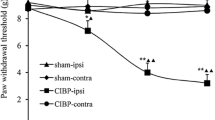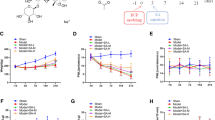Abstract
Cancer-induced bone pain (CIBP) is a common clinical problem in breast cancer patients with bone metastasis. Recent studies shows chemokines are novel targets for treatment of CIBP. In this study, we intra-tibial inoculated with Walker 256 rat mammary gland carcinoma cells into rat bone to established metastatic breast cancer. Then we measured the expression of CXCL10 in the spinal cord of metastatic bone cancer rats, investigated the role of CXCL10 in the development of CIBP, and the underlying mechanism. Results revealed that after intra-tibial inoculation with Walker 256 cells, rats showed up-regulation of CXCL10 and its receptor CXCR3 in the spinal cord. Interestingly, intrathecally injection of recombinant CXCL10 protein induced mechanical allodynia in naïve rats. Blocking the function of CXCL10/CXCR3 pathway via anti-CXCL10 antibody or CXCR3 antagonist prevented the development of CIBP and microglial activation. Moreover, CXCL10-induced mechanical allodynia was rescued by minocycline treatment during the late-stage of CIBP, days 10–14. The regulation of CXCL10 expression involved microglial activation in a manner of autocrine positive feedback. These results suggest that CXCL10 may be a necessary algogenic molecule, especially in the development of CIBP. Its function was partly mediated via spinal microglial activation. This study provides a novel insight into the biological function of chemokine CXCL10 in the molecular mechanism underlying cancer pain. It also provides new target for clinical treatment of metastatic breast cancer-induced bone pain in future.







Similar content being viewed by others
Abbreviations
- CXCL10:
-
C-X-C motif chemokine 10
- CXCR3:
-
C-X-C motif chemokine receptor 3
- rrCXCL10:
-
recombinant rat CXCL10 protein
- GAPDH:
-
glyceraldehyde-3-phosphate dehydrogenase
- CIBP:
-
cancer-induced bone pain
- PWTs:
-
paw withdrawal thresholds
- HPβCD:
-
2-Hydroxypropyl-β-cyclodextrin
- MC:
-
minocycline
- CD11b:
-
integrin alpha M chain, a special molecule in microglia
References
Coleman RE (2006) Clinical features of metastatic bone disease and risk of skeletal morbidity. Clin Cancer Res 12(20 Pt 2):6243s–6249s. doi:10.1158/1078-0432.CCR-06-0931
Middlemiss T, Laird BJ, Fallon MT (2011) Mechanisms of cancer-induced bone pain. Clin Oncol 23(6):387–392. doi:10.1016/j.clon.2011.03.003
Vadalouca A, Raptis E, Moka E, Zis P, Sykioti P, Siafaka I (2012) Pharmacological treatment of neuropathic cancer pain: a comprehensive review of the current literature. Pain Pract 12(3):219–251. doi:10.1111/j.1533-2500.2011.00485.x
Hu JH, Zheng XY, Yang JP, Wang LN, Ji FH (2012) Involvement of spinal monocyte chemoattractant protein-1 (MCP-1) in cancer-induced bone pain in rats. Neurosci Lett 517(1):60–63. doi:10.1016/j.neulet.2012.04.026
Hu JH, Yang JP, Liu L, Li CF, Wang LN, Ji FH, Cheng H (2012) Involvement of CX3CR1 in bone cancer pain through the activation of microglia p38 MAPK pathway in the spinal cord. Brain Res 1465:1–9. doi:10.1016/j.brainres.2012.05.020
Yin Q, Cheng W, Cheng MY, Fan SZ, Shen W (2010) Intrathecal injection of anti-CX3CR1 neutralizing antibody delayed and attenuated pain facilitation in rat tibial bone cancer pain model. Behav Pharmacol 21(7):595–601. doi:10.1097/FBP.0b013e32833e7e2a
Liu M, Guo S, Hibbert JM, Jain V, Singh N, Wilson NO, Stiles JK (2011) CXCL10/IP-10 in infectious diseases pathogenesis and potential therapeutic implications. Cytokine Growth Factor Rev 22(3):121–130. doi:10.1016/j.cytogfr.2011.06.001
Giuliani N, Bonomini S, Romagnani P, Lazzaretti M, Morandi F, Colla S, Tagliaferri S, Lasagni L, Annunziato F, Crugnola M, Rizzoli V (2006) CXCR3 and its binding chemokines in myeloma cells: expression of isoforms and potential relationships with myeloma cell proliferation and survival. Haematologica 91(11):1489–1497
Neville LF, Mathiak G, Bagasra O (1997) The immunobiology of interferon-gamma inducible protein 10 kD (IP-10): a novel, pleiotropic member of the C-X-C chemokine superfamily. Cytokine Growth Factor Rev 8(3):207–219
Sato E, Fujimoto J, Tamaya T (2007) Expression of interferon-gamma-inducible protein 10 related to angiogenesis in uterine endometrial cancers. Oncology 73(3–4):246–251. doi:10.1159/000127422
Aksoy MO, Yang Y, Ji R, Reddy PJ, Shahabuddin S, Litvin J, Rogers TJ, Kelsen SG (2006) CXCR3 surface expression in human airway epithelial cells: cell cycle dependence and effect on cell proliferation. Am J Physiol Lung cell Mol Physiol 290(5):L909–L918. doi:10.1152/ajplung.00430.2005
Shin SY, Nam JS, Lim Y, Lee YH (2010) TNFalpha-exposed bone marrow-derived mesenchymal stem cells promote locomotion of MDA-MB-231 breast cancer cells through transcriptional activation of CXCR3 ligand chemokines. The J Biol Chem 285(40):30731–30740. doi:10.1074/jbc.M110.128124
Muller M, Carter S, Hofer MJ, Campbell IL (2010) Review: The chemokine receptor CXCR3 and its ligands CXCL9, CXCL10 and CXCL11 in neuroimmunity—a tale of conflict and conundrum. Neuropathol Appl Neurobiol 36(5):368–387. doi:10.1111/j.1365-2990.2010.01089.x
Campanella GS, Tager AM, El Khoury JK, Thomas SY, Abrazinski TA, Manice LA, Colvin RA, Luster AD (2008) Chemokine receptor CXCR3 and its ligands CXCL9 and CXCL10 are required for the development of murine cerebral malaria. Proc Nat Acad Sci USA 105(12):4814–4819. doi:10.1073/pnas.0801544105
Strong JA, Xie W, Coyle DE, Zhang JM (2012) Microarray analysis of rat sensory ganglia after local inflammation implicates novel cytokines in pain. PloS one 7(7):e40779. doi:10.1371/journal.pone.0040779
Fu ES, Zhang YP, Sagen J, Candiotti KA, Morton PD, Liebl DJ, Bethea JR, Brambilla R (2010) Transgenic inhibition of glial NF-kappa B reduces pain behavior and inflammation after peripheral nerve injury. Pain 148(3):509–518. doi:10.1016/j.pain.2010.01.001
Cao F, Gao F, Xu AJ, Chen ZJ, Chen SS, Yang H, Yu HH, Mei W, Liu XJ, Xiao XP, Yang SB, Tian XB, Wang XR, Tian YK (2010) Regulation of spinal neuroimmune responses by prolonged morphine treatment in a rat model of cancer induced bone pain. Brain Res 1326:162–173. doi:10.1016/j.brainres.2010.02.039
Liu X, Bu H, Liu C, Gao F, Yang H, Tian X, Xu A, Chen Z, Cao F, Tian Y (2012) Inhibition of glial activation in rostral ventromedial medulla attenuates mechanical allodynia in a rat model of cancer-induced bone pain. J Huazhong Univ Sci Technolog Med Sci 32(2):291–298. doi:10.1007/s11596-012-0051-5
Steinmetz OM, Sadaghiani S, Panzer U, Krebs C, Meyer-Schwesinger C, Streichert T, Fehr S, Hamming I, van Goor H, Stahl RA, Wenzel U (2007) Antihypertensive therapy induces compartment-specific chemokine expression and a Th1 immune response in the clipped kidney of Goldblatt hypertensive rats. Am J Physiol Renal Physiol 292(2):F876–F887. doi:10.1152/ajprenal.00174.2006
Yaksh TL, Rudy TA (1976) Chronic catheterization of the spinal subarachnoid space. Physiol Behav 17(6):1031–1036
Walser TC, Rifat S, Ma X, Kundu N, Ward C, Goloubeva O, Johnson MG, Medina JC, Collins TL, Fulton AM (2006) Antagonism of CXCR3 inhibits lung metastasis in a murine model of metastatic breast cancer. Cancer Res 66(15):7701–7707. doi:10.1158/0008-5472.CAN-06-0709
Fox A, Medhurst S, Courade JP, Glatt M, Dawson J, Urban L, Bevan S, Gonzalez I (2004) Anti-hyperalgesic activity of the cox-2 inhibitor lumiracoxib in a model of bone cancer pain in the rat. Pain 107(1–2):33–40
Saika F, Kiguchi N, Kobayashi Y, Fukazawa Y, Kishioka S (2012) CC-chemokine ligand 4/macrophage inflammatory protein-1beta participates in the induction of neuropathic pain after peripheral nerve injury. Eur J Pain 16(9):1271–1280. doi:10.1002/j.1532-2149.2012.00146.x
Liou JT, Yuan HB, Mao CC, Lai YS, Day YJ (2012) Absence of C-C motif chemokine ligand 5 in mice leads to decreased local macrophage recruitment and behavioral hypersensitivity in a murine neuropathic pain model. Pain 153(6):1283–1291. doi:10.1016/j.pain.2012.03.008
Watkins LR, Maier SF (2002) Beyond neurons: evidence that immune and glial cells contribute to pathological pain states. Physiol Rev 82(4):981–1011. doi:10.1152/physrev.0 0011.2002
Guillot X, Semerano L, Decker P, Falgarone G, Boissier MC (2012) Pain and immunity. Joint, bone, spine : revue du rhumatisme 79(3):228–236. doi:10.1016/j.jbspin.2011.10.008
Schomberg D, Olson JK (2012) Immune responses of microglia in the spinal cord: contribution to pain states. Exp Neurol 234(2):262–270. doi:10.1016/j.expneurol.2011.12.021
Yao M, Chang XY, Chu YX, Yang JP, Wang LN, Cao HQ, Liu MJ, Xu QN (2011) Antiallodynic effects of propentofylline Elicited by interrupting spinal glial function in a rat model of bone cancer pain. J Neurosci Res 89(11):1877–1886. doi:10.1002/jnr.22711
Van Der Meer P, Goldberg SH, Fung KM, Sharer LR, Gonzalez-Scarano F, Lavi E (2001) Expression pattern of CXCR3, CXCR4, and CCR3 chemokine receptors in the developing human brain. J Neuropathol Exp Neurol 60(1):25–32
Rappert A, Bechmann I, Pivneva T, Mahlo J, Biber K, Nolte C, Kovac AD, Gerard C, Boddeke HW, Nitsch R, Kettenmann H (2004) CXCR3-dependent microglial recruitment is essential for dendrite loss after brain lesion. J Neurosci 24(39):8500–8509. doi:10.1523/JNEUROSCI.2451-04.2004
Vinet J, de Jong EK, Boddeke HW, Stanulovic V, Brouwer N, Granic I, Eisel UL, Liem RS, Biber K (2010) Expression of CXCL10 in cultured cortical neurons. J Neurochem 112(3):703–714. doi:10.1111/j.1471-4159.2009.06495.x
Kroeze KL, Boink MA, Sampat-Sardjoepersad SC, Waaijman T, Scheper RJ, Gibbs S (2012) Autocrine regulation of re-epithelialization after wounding by chemokine receptors CCR1, CCR10, CXCR1, CXCR2, and CXCR3. J Invest Dermatol 132(1):216–225. doi:10.1038/jid.2011.245
Park SJ, Burdick MD, Brix WK, Stoler MH, Askew DS, Strieter RM, Mehrad B (2010) Neutropenia enhances lung dendritic cell recruitment in response to Aspergillus via a cytokine-to-chemokine amplification loop. J Immunol 185(10):6190–6197. doi:10.4049/jimmunol.1002064
Korkaya H, Liu S, Wicha MS (2011) Regulation of cancer stem cells by cytokine networks: attacking cancer’s inflammatory roots. Clinical Cancer Res 17(19):6125–6129. doi:10.1158/1078-0432.CCR-10-2743
Acknowledgments
We are grateful to Amgen for kindly providing AMG487 to us. We also gratefully acknowledge the expertise of Ms. Amber Chen (Project Intern, Department of Neuroscience, Baylor College of Medicine, USA) in the proof-reading of the manuscript. This work was supported by grants from the Natural Science Foundation of China (Nos. 81070890, 30872441, 81371250, 81171259, 81100832 and 30901395), and also supported by 2010 Clinical Key Disciplines Construction Grant from the Ministry of Health of China.
Conflict of interest
The authors declare that they do not have financial relationships with any of the organizations that sponsored the research, and they do not have any other real or apparent conflict(s) of interest that may have a direct bearing on the subject matter of the article.
Author information
Authors and Affiliations
Corresponding author
Additional information
Huilian Bu and Bin Shu contributed equally to this work.
Rights and permissions
About this article
Cite this article
Bu, H., Shu, B., Gao, F. et al. Spinal IFN-γ-induced protein-10 (CXCL10) mediates metastatic breast cancer-induced bone pain by activation of microglia in rat models. Breast Cancer Res Treat 143, 255–263 (2014). https://doi.org/10.1007/s10549-013-2807-4
Received:
Accepted:
Published:
Issue Date:
DOI: https://doi.org/10.1007/s10549-013-2807-4




